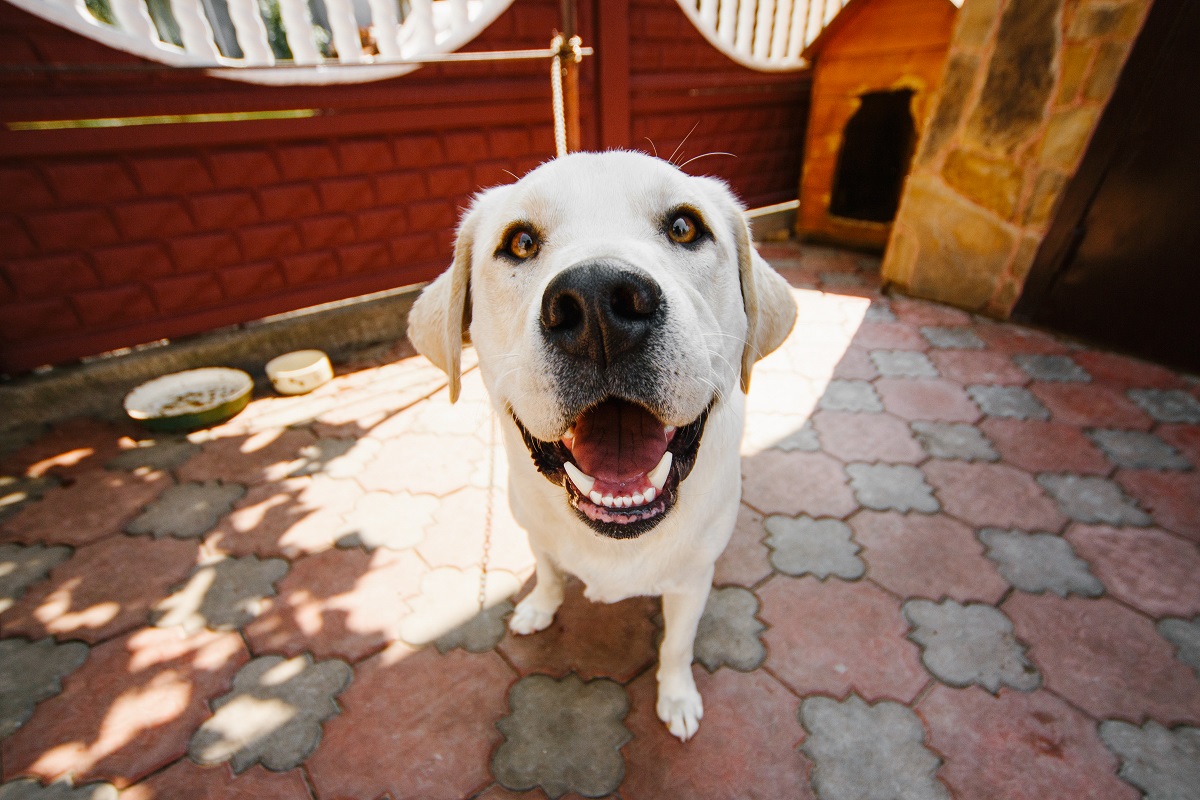Do dogs calm down after being spayed?
Yes… 100 percent… Each and every time.
No dog that’s ever been spayed has been anything but completely calm afterward…
Wouldn’t it be nice if life was that simple?
Unfortunately, it’s not, and the answer is much more complicated than a simple yes or no.
Spaying is a medical procedure designed to stop unwanted pregnancies.
That’s all.
It’s not a magic bullet, it’s not going to ‘fix’ your dog (other than in the literal sense), and it’s not going to guarantee anything besides a puppy-free future.
But (and this is where things get complicated), it can, in certain cases, have an effect on behavior.
To understand why, why need to take a brief (and I promise it will be brief, so don’t worry if you’re squeamish) look at what spaying actually is.
Spaying involves removing the uterus and ovaries of a female dog via a small incision in the abdomen. It’s performed under general anesthesia and is generally considered to be a very safe, minimal risk procedure.
So, how can the removal of reproductive organs affect a dog’s behavior?
Simple – by removing all those pesky hormones that make them fight other females for breeding rights, roam the neighborhood looking for suitors, and get stressed out and irritable during that time of the month.
Basically, spaying stops your dog from being at the whim of their ever-fluctuating hormones.
Sounds good, right?
And it is….providing all of your dog’s behavioral issues are caused by their hormones. If they’re not, spaying won’t change a thing.
If your dog’s hyperactivity and behavioral problems are rooted in something besides hormones, you’ll need to look beyond the scalpel for a solution.
That’s not necessarily going to be easy, but there’s a simple, effective way you can get things off to a flying start.
It’s called the Dog Calming Code, and it’s been put together by Dan Abdelnoor at the Online Dog Trainer to help any dog calm down, focus, and get their emotions under control. (see video below)
It utilizes a very new, very intuitive approach to training that might be different from all the methods you’ve tried in the past. But which could very well be the missing piece in the puzzle you’ve been searching for.
Check out the video link below – it’ll be a lot cheaper than booking surgery and, in all likelihood, a lot more effective too.
(video will open in new window)
Do Dogs Calm Down After Being Spayed?
First of all, let me make one thing very clear. Spaying is by no mean a ‘bad’ thing.
In many, many ways, it’s an excellent thing. Unplanned pregnancies are a major welfare concern, resulting in hundreds of thousands of unwanted dogs living short, horrible lives on the streets or in completely unsuitable homes.
Spaying helps end that.
The problem with spaying starts when people assign it benefits that go way beyond its basic remit.
If you’re considering getting your dog spayed, it’s vital to go into the process with both eyes open. If you don’t, you could end up being bitterly disappointed.
Before you set that appointment, take a moment to consider the pro and cons.
The Pros
Unless you’re talking with a particularly militant anti-spayer, most people agree that spaying will…
Prevent Unwanted Pregnancies
First up, the most valid reason to spay your dog: preventing pregnancy.
When you remove a female dog’s reproduction organs, you’re not ‘denying’ her the pleasure of being a mom.
Dogs aren’t people: they don’t think the same, they don’t want the same things, and they certainly don’t waste their time worrying about things they never had.
What you are doing is eliminating the risk of your home turning into a puppy farm.
And with the problem of unplanned, unwanted litters already out of control. Spaying your dog ensures you don’t end up adding to it.
If you plan on breeding your dog and have already thought through the financial, health, and welfare considerations of doing so, fine.
If you don’t or haven’t, spaying is a very reasonable, very rational way of making sure you never have to.
Reduce Risky Pregnancies
Some dogs, whether because of their health or breed, can experience incredibly risky pregnancies and even riskier labors.
French Boxers, Bulldogs, Pugs, and other brachycephalic dogs are exceptionally prone to birthing difficulties, with most being unable to carry out labor without intervention.
Dogs with cardiac or respiratory problems are similarly at risk.
By eliminating the chance of them falling into the clutches of an amorous male, spaying will keep your dog safe and avoid the potentially tragic results of an unplanned pregnancy.
Cut the Chance Of Cancer
Some of the medical benefits of spaying have occasionally been overstated. But most research suggests that spaying can be enormously beneficial at cutting the risk of conditions such as:
- False pregnancy
- Uterine prolapse
- Cystic ovaries
- Ovarian tumors
- Mastitis
- Breast cancer
- Cystic pyometra
As spaying can help reduce hormonally driven aggression, it also cuts the risk of your dog picking up an injury during a fight.
Put an End to the Heat Cycle
No matter which side of the debate they fall on, the one thing everyone agrees on is that spaying a dog ends the heat cycle.
That means no more fluctuating hormones and no more bloody discharge. In some cases, it also means…
No More Inappropriate Sexual Behavior: Female dogs only tend to get frisky when they’re in heat. Spaying means sexy time is over.
No More Hormonal Aggression: Unspayed females don’t like it when other unspayed females wander onto their patch when they’re in season. With spaying comes an end to the fisticuffs.
No More Roaming: If your dog’s urge to roam kicks in the minute her hormones start surging, expect to see improved recall and less time organizing search parties after spaying.

The Cons
We’ve seen the pros, now for the cons…
It’s Not Always Risk-Free
Spaying is generally considered one of the most trouble-free procedures you can perform on a dog.
The problem is, no kind of surgery is completely without risk. Especially one that’s performed under general anesthetic.
Although a young, healthy dog will usually have no difficulties, older dogs with existing health problems may not get away so lightly.
It’s also worth considering that while spaying can slash the risk of several potentially deadly diseases, it doesn’t guarantee your dog a clean bill of health at the end of it.
For example, some research seems to suggest that spayed dogs are twice as likely to develop hemangiosarcoma of the spleen and five times as likely to develop hemangiosarcoma of their unspayed counterparts.
It’s Not a Cure-All
Spaying is a medical procedure performed on the reproductive organs. It’s not brain surgery, and it’s not going to do anything to change your dog’s behavior if that behavior isn’t hormonal.
So sure, it might stop hormonally driven aggression. But is it going to fix fear-based aggression?
…Nope.
Is it going to undo a lifetime of bad habits?
…Not even slightly.
Is it going to correct the problems caused by lax training, poor socialization, genetics, and upbringing?
…Not on your nelly.
Ultimately, a dog is more than a walking bag of hormones. If they’re boisterous and unruly, the problem is much more likely to stem from training and upbringing than their ovaries.
Do nothing about the former, and removing the latter is going to leave you no better off than you were before.
It’s Expensive
Depending on where you live, you can expect to pay anything up to around $300 for your dog to be spayed.
Now obviously, that’s a heck of a lot less than a litter of pups is going to cost you. But if you’re spaying your dog purely to calm them down, you might want to consider whether it’s worth the dent in your wallet.
It’s Irrevisble
After they’ve finished the procedure, your vet won’t hand over your dog’s ovaries in a jar just in case you want to pop them back in at a later date.
Once it’s done, there’s no turning back the clock.
For most people, that’s not a concern.
If, on the other hand, you’ve always had a niggling desire to breed your dog, and if you know there are no financial or health barriers in the way of doing that, you might want to give it some serious thought beforehand.
Related Post: How To Deal With Female Dog Aggression After Spaying

How to Calm a Dog Without Spaying
If you want to ensure your dog never surprises you with a litter of pups, go right ahead and spay them.
However, if you want to stop them from jumping over your guests, pulling on the leash, or using your bed as a bouncy castle, you’ll need to go a different route.
Here’s how…
Figure It Out
Before you do anything else, try to work out what’s behind your dog’s behavior.
If they’re perfectly well behaved most of the time but turn into uncontrollable sex fiends whenever their heat cycle kicks in. Spaying could well be the solution to your problems.
If they’re just generally rowdy, overexcitable, and hard to handle, ask yourself why.
- Have you invested enough time in training?
- Where they socialized as pups?
- Are they calm around family but whirling dervishes around strangers and unfamiliar dogs?
The more you learn about the root cause of the problem, the easier you’ll find it to spot which training holes need to be plugged.
Teach Them Emotional Control
If your dog is rowdy, boisterous, and in the habit of letting their excitement run away with them, it’s time to teach them the value of emotional control.
If that sounds complicated, stick with me. Or rather, stick with Dan Abdelnoor, who’s developed a program that’s specifically designed to help focus and calm even the most hyper pooch in the doggy kingdom.
The Dog Calming Code isn’t hard to implement. You’re not going to struggle to understand the techniques, and your dog’s not going to find the whole thing a major pain in the proverbial.
It’s simple, intuitive, and a guaranteed way to build a healthier relationship with your dog.
Check out the link to see for yourself.
Get Active
It might have been said a hundred times already, but a tired dog really is a happy dog.
If your dog doesn’t get the right amount of mental and physical stimulation they need, they’ll find some other way to offload their energy.
Unfortunately, that rarely spells good things for a peaceful home life.
Work out how much exercise your dog needs (bearing in mind age, breed, and overall health) and give it to them.
It might mean you have to get a dog walker to pop by while you’re at work.
Or it could mean you need to think about enrolling them in an agility or coursing class.
Sometimes, it could be as simple as treating them to a few extra sessions of frisbee at the park or investing in a few interactive games to keep their minds busy.
Regardless of which method you use, the more exhausted they are by bedtime, the happier everyone will be.
Go Back to Basics
Every dog needs to be trained and socialized.
If they’re not, they’ll always be at risk of getting nervy and jumpy around unfamiliar things.
If they’re not trained, you’ll never be able to establish a healthy degree of control over their behavior.
Neither one is complicated, but each is essential.
Socialization is best done from a young age, but don’t worry if they’ve already blown out their fair share of birthday candles – it’s never too late to start.
Aim to introduce them to a wide variety of people, places, sounds, sights, and animals. Go slowly, keep the introductions gentle and controlled, and use plenty of treats to grease the wheels.
Mastering training is just as easy.
Basic obedience commands like ‘sit,’ ‘fetch,’ and ‘leave’ can be taught simply enough. But if you’re worried about your own skills, there’s no shame in enrolling them in an obedience class.
If they get easily distracted during training sessions, the Dog Calming Code will help keep them in the zone.
Ignore the Bad, Reward the Good
Dogs love attention. They don’t really care whether it’s good attention or bad attention, providing they’re getting it.
Learn to walk away whenever your dog starts demanding your time with their antics. Turn your back, look the other way, and blank them till they calm down.
Once they’re completely calm, praise them gently and offer them a treat.
Once they learn that acting politely gets them a reward and behaving badly gets them nothing, you can guess which one they’ll start to favor.

Wrapping Things Up
There’s no question that spaying comes with some amazing benefits. As a means to cut the risk of uncontrolled breeding, it’s unbeatable.
As a way to reduce the likelihood of certain diseases, it’s excellent.
But as a way to change your dog’s behavior?
…Not so much.
If your dog is roaming, indulging in inappropriate sexual behaviors, and getting into fights with other unspayed females, spaying will be a godsend.
If they’re acting rowdy because they’ve not been taught any better, forget it.
Training. Exercise. Socialization. Emotional Control. These are the things that will make a difference.
Yes, they might involve a lot more work on your part than simply picking up the phone and calling the vet. The difference is, they’ll actually work.

